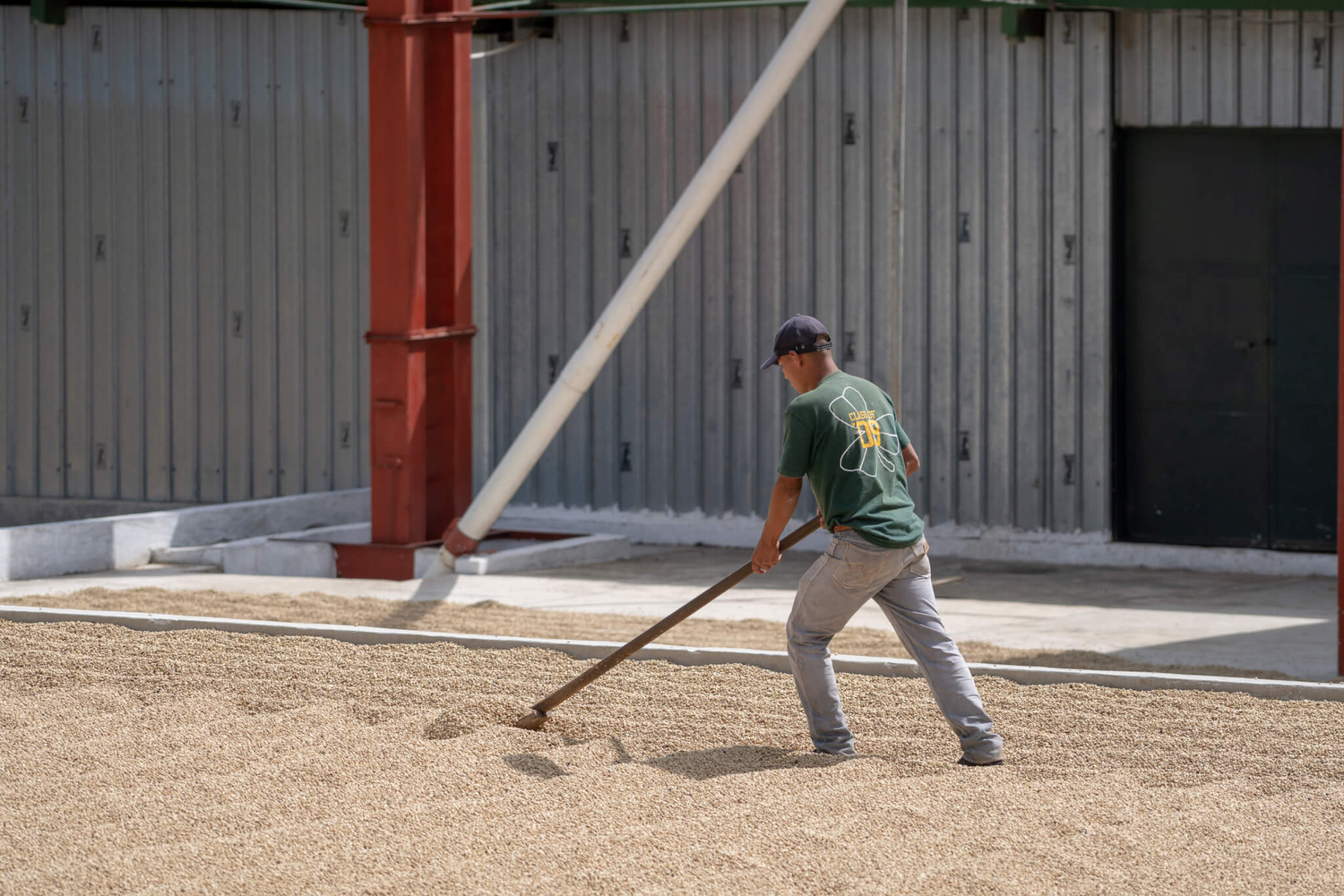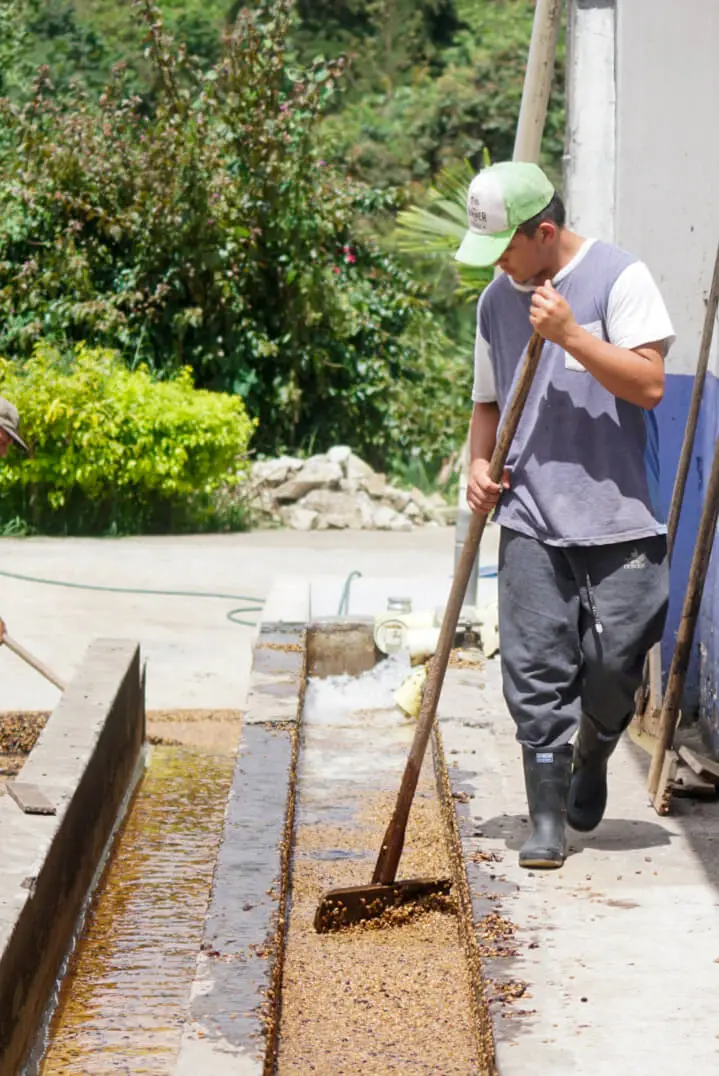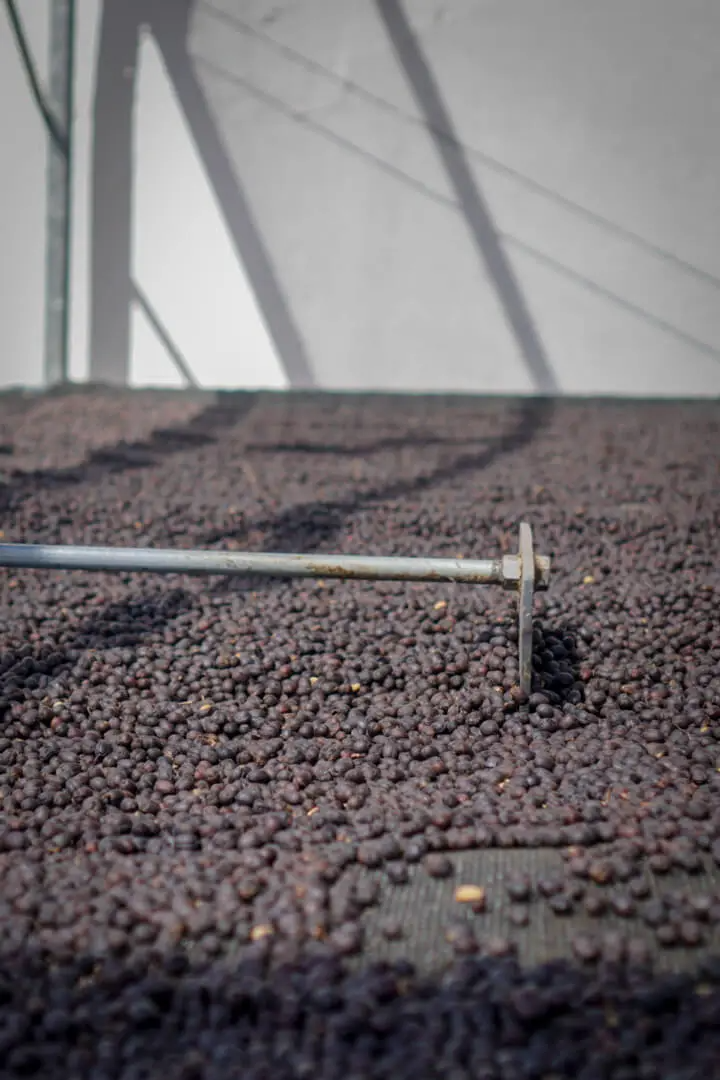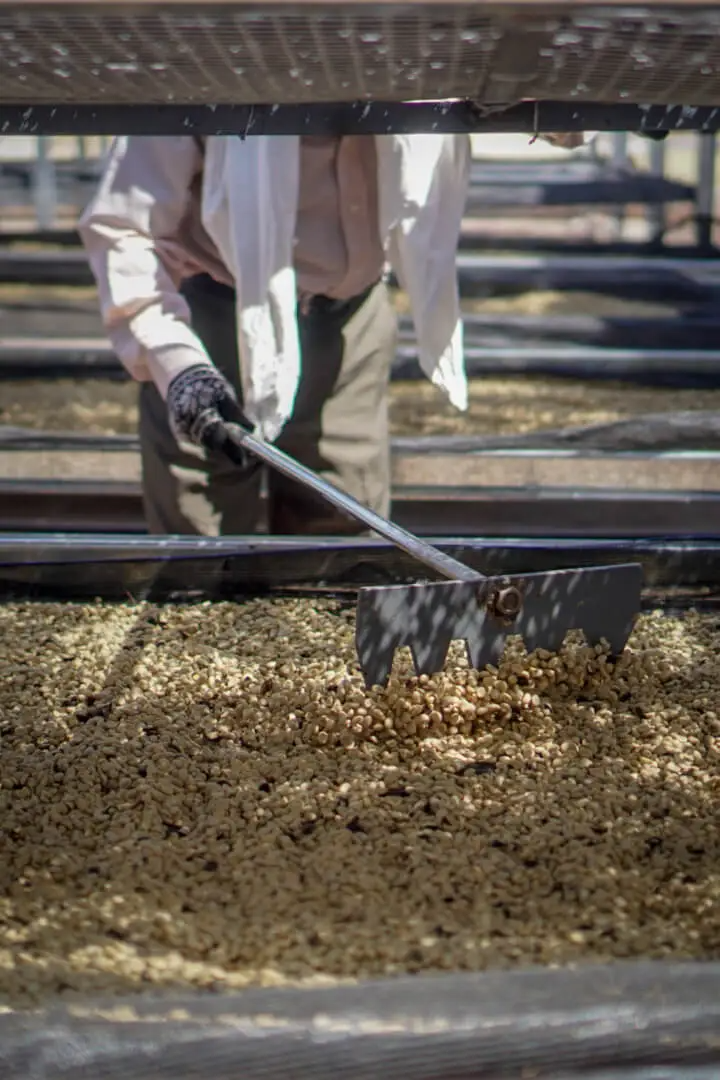
Coffee processing
Ever wondered what the difference is between natural process and washed process coffee is? Here's what you need to know about the different ways coffee is processed.
Washed Process (aka Wet Process)
FRUIT REMOVAL
Typically within 24 hours of harvest.
FERMENTATION
Depulped coffees are typically held in “fermentation tanks” for 12–72 hours; demucilaged coffees are not commonly held in tanks but moved to drying surfaces or equipment.
DRYING TIME
18–36 hours mechanically; 7–15 days on patios, raised beds, or in parabolic dryers.
PROFILE
Clean, articulate flavours; caramel or sugary sweetness; wide spectrum of fruit acidity depending on other factors; capable of bright, crisp notes.

The quickest and arguably the most efficient of the post-harvest processing methods is often called Washed or Wet process, though, confusingly, it doesn’t always require water. This process is the primary method for preparing specialty-quality coffee in most of Africa, Central and South America (with the exception of Brazil), and select parts of the Asia-Pacific growing region.
Based on place, tradition, climate, and access to resources such as fresh water, your mileage may vary on the particular approach any number of producers will take, but “Washed” as a loose definition typically means that the coffee fruit has been removed from the coffee seed as quickly and as cleanly as possible. Some professionals and even some coffee markets and contracts differentiate between “Fully Washed,” which does use water, and other types of “Washed” coffees, such as those that have their mucilage mechanically removed.
This process is probably the one in which the use of the term “fermentation” is most often used incorrectly, as we often assume that fermentation happens only when the seeds are stored, contained, or held in an actual “fermentation tank.” On the contrary, fermentation begins the moment there is an access point in the fruit that allows microorganisms like yeast and bacteria to begin metabolizing sugars such as fructose and sucrose. Often, this access point is created at the time of picking, when the fruit and stem are separated and a small hole is typically created. Fermentation can take place in Washed coffees as long as there is either fruit material (mucilage) and/or a certain amount of water (11% moisture) available as a fuel source.
That being said, generally in the coffee industry we describe the “length of fermentation” as being a period of time in which coffee is piled in tanks or held underwater, with the goal of either accelerating or retarding the ability and access that microorganisms have to the fruit material. “Open,” or “dry fermentation” are terms used to describe coffees that are depulped (have their skin removed) and are then placed in open-air tanks or buckets and allowed to sit in their mucilage, typically for 24 hours or less though occasionally for as long as 72 hours. “Underwater,” or “wet fermentation” can take longer, depending on the climate, water quality, and activated populations of microorganisms.
Natural Process (aka Sun-Dried or Dry Processed)
FRUIT REMOVAL
After drying.
FERMENTATION
Occurs inside the fruit mucilage surrounding the seed an under the pulp, will take place as long as there is fuel available to the microorganisms (e.g. sugar, water, acids, etc).
DRYING TIME
Up to 30–45 days, weather permitting.
PROFILE
Noticeably fruity or “pulpy” flavours, often described as “boozy” or “winey’; can also have strong nutty and/or chocolate characteristics, and typically has a heavier or syrupy body.

While Washed coffees have their fruit removed relatively quickly after harvesting, Natural or “Dry” process coffees are something like the opposite, in a manner of speaking: The fruit is instead picked when ripe and allowed to dry completely around the seed before being husked or hulled off. While historically this hulling was done by hand with a kind of mortar-and-pestle setup, today it is largely done by machinery that can be finely calibrated. Natural process coffees are most commonly found in Ethiopia, Yemen, Brazil, and Costa Rica, though producers around the world are also experimenting with this methodology.
As with all coffee preparation, there is fermentation occurring during the processing, from the moment the coffee is picked (or possibly earlier, whenever an access point is created in the fruit). Local or intentional populations of yeast and bacteria will enter the fruit at the access point and begin to metabolize the sugars and acids inside the coffee fruit immediately, a process that can continue until the coffee is dried to the standard of 11%. While the coffee itself is not held in “fermentation tanks,” its fermentation process is altered and can be dictated by things like ambient temperature and exposure to full sun or shade; depth of the drying bed; rotation of the coffee during drying, etc.
Drying Natural coffees is considerably longer and the overall process is riskier than for Washed coffee, which hints at some reasons the Washed technique was developed: Naturals take more space on drying surfaces, require more attention and labour (to prevent mold and infestation during drying, for example), and are constantly at potential risk for spoilage or “overfermentation,” as the fruit material that is intact on the seeds provides a longterm and concentrated fuel source for yeast and bacteria to metabolize.
Natural processing is the oldest basic technique for preparing coffee, and in ancient times (as well as currently in some cultures and applications), it’s possible that the coffee fruit was allowed to dry completely while still on the branch, allowing it to be harvested only when needed. Modern Natural coffees are harvested ripe and intentionally dried, typically on patios, raised beds, or drying tables; they cannot be dried in mechanical dryers like Washed coffees can.
Pulped Natural / Honey Process
FRUIT REMOVAL
Fruit skin is removed within 24 hours of harvest; all or some of the mucilage is left to dry on the seeds.
FERMENTATION
Occurs throughout the drying process.
DRYING TIME
18–30 days.
PROFILE
Can express some fruity/pulpy/jammy flavours or stewed-fruit-like characteristics; caramel or burnt-sugar sweetness; nuttiness.

The “pulp” is often what coffee-cherry skin is called, and by this logic, “Pulped Natural” coffee is a kind of variation on the Natural process that removes the skin of the coffee cherry while leaving behind the sticky fruit mucilage that was underneath it. This process is most commonly found in Brazil, where it was developed as a means of retaining some of the desirable characteristics of a full Natural coffee (heavy body, sweet fruitiness with lower acidity, deep chocolate notes) while also speeding the drying process considerably, and reducing some of the risk of spoilage, mold, and other defects that can occur with fully intact coffee cherry on the drying patios or tables.
In a similar vein, Costa Rica has become famous for the emergence of a similar process, most typically called Honey. This is also a technique that calls for the removal of the skin from the fruit, and for some or all of the mucilage to remain intact to ferment and dry on the seed. In many cases in the Costa Rican variation, producers will remove different amounts of the mucilage material in order to manipulate the coffee’s finished profile, assigning differentiating terms to correspond with the results, from Yellow Honey (the mildest, perhaps closest to Washed coffees), Red Honey, and Black Honey (which is arguably most comparable to the Brazilian Pulped Natural).
Whether Pulped Natural or Honey, the obvious benefit to this process over strict naturals is the speed and efficiency of the drying process, as well as the various flavour characteristics that can emerge through fermentation and exposure. On the other hand, the exposed fruit material does create more risk for the producers, as it requires more labor in drying to prevent taints from developing. These coffees will also often have an uneven or inconsistent appearance in their green forms, which can be unappealing for roasters who are used to the more uniform cleanliness of a washed coffee.